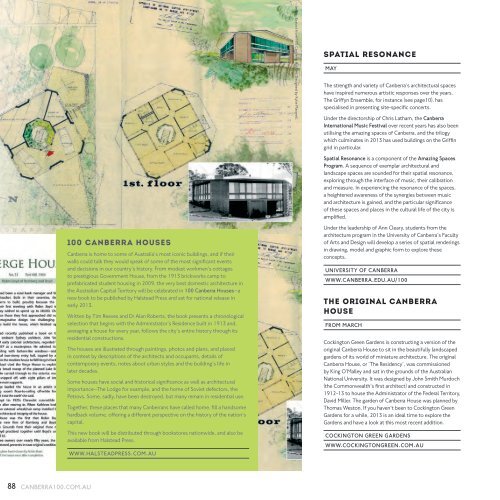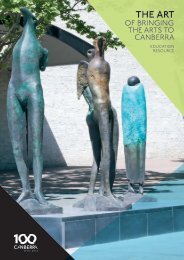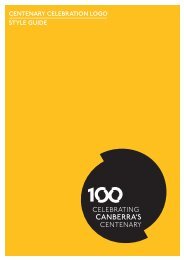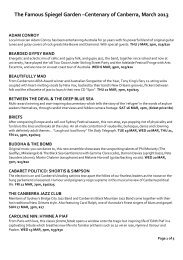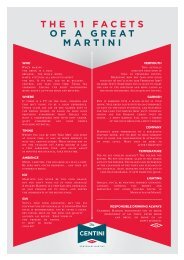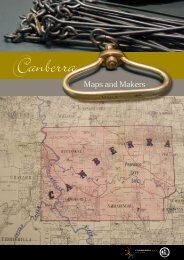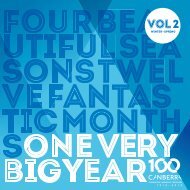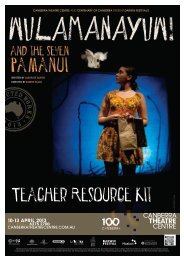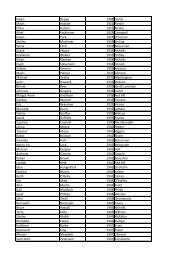Volume One - Pages 77 to 108 - Canberra 100
Volume One - Pages 77 to 108 - Canberra 100
Volume One - Pages 77 to 108 - Canberra 100
You also want an ePaper? Increase the reach of your titles
YUMPU automatically turns print PDFs into web optimized ePapers that Google loves.
<strong>100</strong> <strong>Canberra</strong> Houses<br />
<strong>Canberra</strong> is home <strong>to</strong> some of Australia’s most iconic buildings, and if their<br />
walls could talk they would speak of some of the most significant events<br />
and decisions in our country’s his<strong>to</strong>ry. From modest workmen’s cottages<br />
<strong>to</strong> prestigious Government House, from the 1913 brickworks camp <strong>to</strong><br />
prefabricated student housing in 2009, the very best domestic architecture in<br />
the Australian Capital Terri<strong>to</strong>ry will be celebrated in <strong>100</strong> <strong>Canberra</strong> Houses—a<br />
new book <strong>to</strong> be published by Halstead Press and set for national release in<br />
early 2013.<br />
Written by Tim Reeves and Dr Alan Roberts, the book presents a chronological<br />
selection that begins with the Administra<strong>to</strong>r’s Residence built in 1913 and,<br />
averaging a house for every year, follows the city’s entire his<strong>to</strong>ry through its<br />
residential constructions.<br />
The houses are illustrated through paintings, pho<strong>to</strong>s and plans, and placed<br />
in context by descriptions of the architects and occupants, details of<br />
contemporary events, notes about urban styles and the building’s life in<br />
later decades.<br />
Some houses have social and his<strong>to</strong>rical significance as well as architectural<br />
importance—The Lodge for example, and the home of Soviet defec<strong>to</strong>rs, the<br />
Petrovs. Some, sadly, have been destroyed, but many remain in residential use.<br />
Together, these places that many <strong>Canberra</strong>ns have called home, fill a handsome<br />
hardback volume, offering a different perspective on the his<strong>to</strong>ry of the nation’s<br />
capital.<br />
This new book will be distributed through books<strong>to</strong>res nationwide, and also be<br />
available from Halstead Press.<br />
WWW.HALSTEADPRESS.COM.AU<br />
Image: Extract from <strong>100</strong> <strong>Canberra</strong> Houses, Designed by Kylie Maxwell.<br />
SPATIAL RESONANCE<br />
MAY<br />
The strength and variety of <strong>Canberra</strong>’s architectural spaces<br />
have inspired numerous artistic responses over the years.<br />
The Griffyn Ensemble, for instance (see page10), has<br />
specialised in presenting site-specific concerts.<br />
Under the direc<strong>to</strong>rship of Chris Latham, the <strong>Canberra</strong><br />
International Music Festival over recent years has also been<br />
utilising the amazing spaces of <strong>Canberra</strong>, and the trilogy<br />
which culminates in 2013 has used buildings on the Griffin<br />
grid in particular.<br />
Spatial Resonance is a component of the Amazing Spaces<br />
Program. A sequence of exemplar architectural and<br />
landscape spaces are sounded for their spatial resonance,<br />
exploring through the interface of music, their calibration<br />
and measure. In experiencing the resonance of the spaces,<br />
a heightened awareness of the synergies between music<br />
and architecture is gained, and the particular significance<br />
of these spaces and places in the cultural life of the city is<br />
amplified.<br />
Under the leadership of Ann Cleary, students from the<br />
architecture program in the University of <strong>Canberra</strong>’s Faculty<br />
of Arts and Design will develop a series of spatial renderings<br />
in drawing, model and graphic form <strong>to</strong> explore these<br />
concepts.<br />
UNIVERSITY OF CANBERRA<br />
WWW.CANBERRA.EDU.AU/<strong>100</strong><br />
the original canberra<br />
house<br />
FROM MARCH<br />
Cocking<strong>to</strong>n Green Gardens is constructing a version of the<br />
original <strong>Canberra</strong> House <strong>to</strong> sit in the beautifully landscaped<br />
gardens of its world of miniature architecture. The original<br />
<strong>Canberra</strong> House, or ‘The Residency', was commissioned<br />
by King O'Malley and sat in the grounds of the Australian<br />
National University. It was designed by John Smith Murdoch<br />
(the Commonwealth's first architect) and constructed in<br />
1912-13 <strong>to</strong> house the Administra<strong>to</strong>r of the Federal Terri<strong>to</strong>ry,<br />
David Miller. The garden of <strong>Canberra</strong> House was planned by<br />
Thomas Wes<strong>to</strong>n. If you haven't been <strong>to</strong> Cocking<strong>to</strong>n Green<br />
Gardens for a while, 2013 is an ideal time <strong>to</strong> explore the<br />
Gardens and have a look at this most recent addition.<br />
COCKINGTON GREEN GARDENS<br />
WWW.COCKINGTONGREEN.COM.AU<br />
88<br />
CANBERRA<strong>100</strong>.COM.AU


